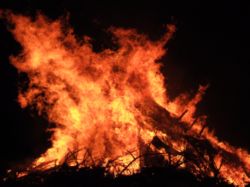Fire

Fire is a result of a thermal interaction between oxygen and a fuel source (wood, or gasoline, for example). It is an observable side effect from an exothermal chemical reaction: the energy produced is released in the form of heat. The typical events in the creation of fire are as follows:
- a fuel source is affected by heat until it reaches its ignition temperature
- oxidation occurs; oxygen molecules break down larger molecules into carbon dioxide and water vapour
- this reaction produces a visible, incandescent body of heated gas which sustains the reaction until either the fuel is expended or there is no more oxygen available to the reaction
As long as all three properties of heat, oxygen, and fuel are present a fire will continue to burn. Removing any one of these elements will either remove the ability for a fire to start or will extinguish it.
The harnessing of fire is said to have been a pivotal event in mankind's developmental history.
Characteristics
Because fire is an observable effect, the varying properties can be identified. The height of the flame, for example, is usually dependant on the heat release rate of the fuel (the heat available or released(intensity) per square space, usually measured in Kw(Kilowatts) or Mw/sq.m.(Megawatts per square meter)) and the available oxygen consumption given the location of the fire.[1].
The color of fire can also be different depending on the type of fuel present in the reaction. Butane and Propane usually produce a blue hue when burning, whereas wood fires are usually yellow in color.
In the context of solids, liquids and gasses, fire or flame is mostly a gas, but one which has been ionized. In the volume of fire, gaseous CO2 and other compounds are raised into the air, along with the photons that emit light from the chemical reactions taking place. In different color fires, more oxygen exists in the reactions, speeding them up. This higher reaction rate produces an environment with a higher temperature, which means less compounds are rising into the air, and consequently less photons are being emitted.
Ultimately, what we see is the light produced from these reactions.
History
It is hard to say when or where fire was first observed or discovered. Evidence from an excavation in the Benot Ya'aqov region of Israel have turned up burned fragments of flint and wood[2] that date from the Acheulian culture(1.8 mil. to 250,000 years ago), are some of the earliest available records of fire use in Eurasia. Evidence in the form of burnt bone in Africa was additionally discovered in 1986 when Bob Brain discovered a deposit approximately 6 meters thick in Swartkrans[3][4]. This finding possibly predated by a million years a discovery in Zhoukoudian, China, associated with Peking Man (H. erectus) circa 400,000 years ago[5]. Whenever it was actually discovered, fire was an integral part of human culture and survival.
Application Vs. Incident
Despite mankind's ability to harness the power of fire, it still remains a wildly destructive force. The energy produced by fire has a variety of uses in manufacturing and production, entertainment, and in research and development. However, this same energy has been the cause of natural disasters that accrued over $1 Billion USD in costs[6], making up as much as ten percent of the total natural disasters between 1980 and 2006[7]. Additionally, the impact that fires can have has resulted in major losses throughout the 19th-21st centuries[8]. A few of those are:
- The Great 1906 San Francisco Earthquake and Fire
- The Great Chicago Fire
- Los Alamos Wildland Fire
- The MGM Grand Hotel Fire in Las Vegas
The recognition of this capability has lead to a great need for fire departments and other resources to minimize and or contain the resulting destruction.
References
- ↑ Jones, Sr., Barry R. CFI (05-18-2003). FAQ - Fire and arson, explosions, fire science, forensic engineering, and other fire related topics. Retrieved on 08-10-2007.
- ↑ Barach, Jerry (2004-04-30). Earliest evidence of use of fire in Eurasia discovered in Hebrew University Excavations at Benot Ya’aqov. Retrieved on 08-09-2007.
- ↑ Armstrong, Sue (1994). "South Africa - The Missing Pieces". New Scientist: 33.
- ↑ Levin, Eric (2005). "First Campfire Discovered in South Africa". Discover: 44.
- ↑ Weiner, Steve et al (1998). "Evidence for the use of fire at Zhoukoudian, China". Science 281: 251-253.
- ↑ 1980-2006 Billion Dollar U.S. Weather Disasters (Chronological). NOAA's National Climatic Data Center (2007). Retrieved on 2007-08-12.
- ↑ 1980-2006 Billion Dollar U.S. Weather Disasters (by State). NOAA's National Climatic Data Center (2007). Retrieved on 2007-08-12.
- ↑ 25 largest fire losses in U.S. history (in 2004 dollars). National Fire Protection Agency (2007-04-06). Retrieved on 2007-08-12.